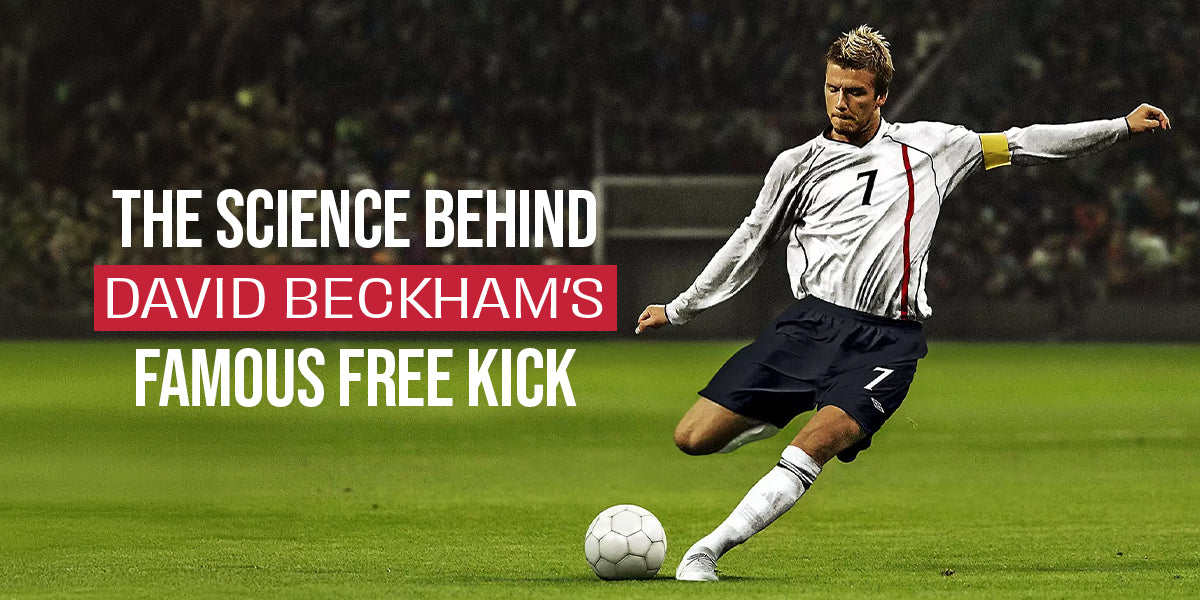The Science Behind David Beckham's Famous Free Kick

Have you ever wondered how the soccer legend David Beckham mastered his famous free kick? This technique that combines elements of biomechanics, physics, and sports science has allowed Beckham to consistently bend the ball around a wall of defenders and straight into the back of the net! His success in effortlessly executing these technical kicks can be achieved with the use of body mechanics, aerodynamics, and the use of combined force and angle. Even though the science behind the free kick is extremely complex, with a better understanding of the technique and a lot of practice, you could master it too. Let’s breakdown everything you need to know about David Beckham’s famous free kick technique and how you can incorporate it into your own routine!
David Beckham’s Free Kick Technique
David Beckham’s free kick technique is legendary in the world of soccer. Known for its accuracy and power, his approach to the ball involves a straight angle. Beckham’s point of contact on the soccer ball is precise, resulting in goals that find the top left corner of the net. Utilizing his plant foot for stability, he generates power by striking the side of the ball, resulting in swerve and dip. His trademarked technique has inspired players all over the world due to its consistency and how difficult it is for goalkeepers to save. Beckham was unmatched in his free kick prowess throughout his career, both domestically and internationally. His goal count from direct free kicks consistently ranked among the highest, securing titles and victories for his teams.
The Magnus Effect
In order to master David Beckham’s perfectly executed free kick, you must first understand the physics behind it. The secret to Beckham’s bending free kicks lies in the physics of the ball’s curving motion, also known as the Magnus Effect. This is achieved when Beckham strikes the ball off-center, creating a difference in pressure on either side of the ball. The rotation of the ball causes air pressure to be lower on one side and higher on the other, resulting in a curved trajectory. Although the concept of the Magnus Effect seems simple enough, it still takes a lot of practice to achieve the perfect curve.
Trajectory & Angle
Aerodynamics also plays a pivotal role in achieving the perfect free kick. David Beckham mastered the art of reducing air resistance by hitting the ball with a precise part of his foot, allowing it to glide through the air with minimal drag. The angle of his strike, combined with the initial velocity, determines the trajectory of the ball. By adjusting the angle of your foot and position of your body when you strike the ball, you can master controlling its flight path.
Force & Velocity
Did you know that mastering the precise amount of force you use to kick the ball is just as important as the trajectory and angle? When it comes to David Beckham’s famous free kick, force, velocity, and angle all go hand-in-hand. Beckham strikes the ball with a combination of speed and precision, which in turn generates the necessary velocity for the ball to reach the goal.
The Sweet Spot
Any experienced soccer player will agree that every soccer ball has a sweet spot or an optimal point for contact. David Beckham understood this theory and perfected his ability to consistently hit the perfect spot on the ball when executing his famous free kick. One secret you may not know, however, is Beckhams use of the valve to impact the ball’s flight path. Although the science behind this technique is not conclusive, he was known to position the ball so that his foot would connect with the valve, which he believed would help him achieve the perfect bend.
Practice Makes Perfect
David Beckham’s legendary free kicks weren’t just a result of talent, it was the result of countless hours of practice and dedication - just like any other skill. Now that you have a better understanding of the science behind achieving the famous free kick, you can practice these techniques on your own. For starters, work on developing your foot positioning and angle of approach. Practice executing the Magnus Effect by striking the ball off-center and aiming for the top left corner of the net. Also work on finding the “sweet spot” of the ball and having your foot connect with the valve when you kick. Experiment with different flight paths by adjusting your plant foot angle and point of contact. Remember above all else to practice, practice, practice until you develop the muscle memory you need to bend it like Beckham!
- Tags: LIFESTYLE
0 comments













